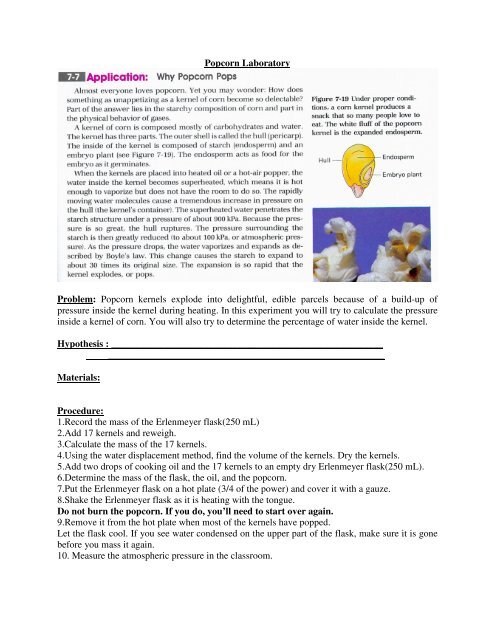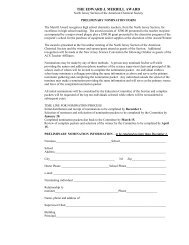Popcorn Laboratory Problem: Popcorn kernels explode into ...
Popcorn Laboratory Problem: Popcorn kernels explode into ...
Popcorn Laboratory Problem: Popcorn kernels explode into ...
You also want an ePaper? Increase the reach of your titles
YUMPU automatically turns print PDFs into web optimized ePapers that Google loves.
<strong>Popcorn</strong> <strong>Laboratory</strong><br />
<strong>Problem</strong>: <strong>Popcorn</strong> <strong>kernels</strong> <strong>explode</strong> <strong>into</strong> delightful, edible parcels because of a build-up of<br />
pressure inside the kernel during heating. In this experiment you will try to calculate the pressure<br />
inside a kernel of corn. You will also try to determine the percentage of water inside the kernel.<br />
Hypothesis : ________________________________________________________<br />
_________________________________________________________<br />
Materials:<br />
Procedure:<br />
1.Record the mass of the Erlenmeyer flask(250 mL)<br />
2.Add 17 <strong>kernels</strong> and reweigh.<br />
3.Calculate the mass of the 17 <strong>kernels</strong>.<br />
4.Using the water displacement method, find the volume of the <strong>kernels</strong>. Dry the <strong>kernels</strong>.<br />
5.Add two drops of cooking oil and the 17 <strong>kernels</strong> to an empty dry Erlenmeyer flask(250 mL).<br />
6.Determine the mass of the flask, the oil, and the popcorn.<br />
7.Put the Erlenmeyer flask on a hot plate (3/4 of the power) and cover it with a gauze.<br />
8.Shake the Erlenmeyer flask as it is heating with the tongue.<br />
Do not burn the popcorn. If you do, you’ll need to start over again.<br />
9.Remove it from the hot plate when most of the <strong>kernels</strong> have popped.<br />
Let the flask cool. If you see water condensed on the upper part of the flask, make sure it is gone<br />
before you mass it again.<br />
10. Measure the atmospheric pressure in the classroom.
Results:<br />
1. Mass of the 250 mL Erlenmeyer flask = ______ g<br />
2. Mass of the 250 mL Erlenmeyer flask + 17 <strong>kernels</strong> = ______ g<br />
3.Calculate the mass of the 17 <strong>kernels</strong> ______ g<br />
4.Volume of the 17 <strong>kernels</strong> ______ mL=______ L<br />
5.Mass 2 drops of oil + 17 <strong>kernels</strong> of popcorn + 250 mL flask = ______ g<br />
6.Cool the flask and mass its content after popping the <strong>kernels</strong> = ______ g<br />
(remove wire lid and the water vapour at the top)<br />
7.Number of un popped <strong>kernels</strong> = ______ g<br />
8.Mass of the popped <strong>kernels</strong> = ______ g<br />
9.Atmospheric pressure ______ kPa<br />
10.Molar mass of water(H2O) ______ g/mol<br />
11.Temperature of the boiling oil 273.15 K + 225˚C = ______ K<br />
Calculations:<br />
1.Determine the percentage of water in the kernel that popped.<br />
Mass of water lost ( Results #5 - #6) x 100 = _______%<br />
Mass of 17 <strong>kernels</strong> (Result #3)<br />
2.Determine the pressure (p) inside the <strong>kernels</strong> that popped (pv = nRT)<br />
3.Calculate the % of <strong>kernels</strong> that didn’t pop.<br />
Number of un popped <strong>kernels</strong> x 100 =<br />
Number total of <strong>kernels</strong><br />
Assessing <strong>Laboratory</strong> Learning:<br />
1.How does heating popcorn affect the pressure inside the popcorn ?<br />
2.a) Name four variables that characterize a confined sample of gas.<br />
b) Which variables can be solved for by using the ideal gas equation ?<br />
3.Calculate the pressure of 1.65 g of helium gas at 16˚C and occupying 3.25 L.<br />
4.What mass of oxygen gas (in grams) is in 2-L container of this gas at 25˚C and<br />
pressure of 202.65 kPa ?
<strong>Popcorn</strong> lab teacher version<br />
Material : -safety glasses -heating plate -<strong>kernels</strong> -oil<br />
-Erlenmeyer flask 250 mL -aluminum square -eye dropper -tongue<br />
Results:<br />
1. Mass of the 250 mL Erlenmeyer flask. 125.19 g<br />
2. Mass of the 250 mL Erlenmeyer flask + 17 <strong>kernels</strong> 128.13 g<br />
3.Calculate the mass of the 17 <strong>kernels</strong> = 2.94 g<br />
4.Volume of the 17 <strong>kernels</strong> 2 mL= 0.002 L<br />
5.Mass 2 drops of oil + 17 <strong>kernels</strong> of popcorn + 250 mL flask = 128.13 g<br />
6.Cool the flask and mass its content after popping the <strong>kernels</strong> = 127.78 g<br />
(remove wire lid and the water vapour at the top)<br />
7.Number of unpopped <strong>kernels</strong> = 2<br />
8.Mass difference after the <strong>kernels</strong> pop = 0.35 g<br />
9.Atmospheric pressure = ? kPa<br />
10.Molar mass of water = 18.02 g/mol<br />
11.Temperature of the boiling oil 273.15 K + 225˚C = 498.15 K<br />
Calculations:<br />
1.Determine the percentage of water in the kernel that popped.<br />
Mass of water lost ( Results #5 - #6) x 100 =128.13 – 127.78 = 11.91 % (usually between 2 & 10 %)<br />
Mass of 17 <strong>kernels</strong> (Result #1) 2.94<br />
2.Determine the pressure(p) inside the <strong>kernels</strong> that popped (pv = nRT)<br />
p= ? pv = mRT<br />
v= 0.002 L M<br />
m= 0.35 g p • 0.002 = 0.35 • 8.31 • 498.15<br />
M= 18.02 g/mol 18.02<br />
R= 8.31 kPa • L / mol • K p = 40 201.7 kPa (usually over 30 000 kPa)<br />
T= 498.15 K<br />
3.Calculate the % of <strong>kernels</strong> that didn’t pop.<br />
Number of unpoped <strong>kernels</strong> x 100 = 2 x 100 = 11.76 %<br />
Total number of <strong>kernels</strong> 17
Assessing <strong>Laboratory</strong> Learning:<br />
1.How does heating popcorn affect the pressure inside the popcorn ?<br />
As the popcorn heats , the water in the kernel vaporizes with about a thousand<br />
fold increase in volume. (The volume of 1 mole of liquid water is 18 mL where<br />
as a mole of vapor is about 22 000 mL. Since it is confined, the volume can’t<br />
increase but pressure will in direct proportion.)<br />
2.a) Name four variables that characterize a confined sample of gas.<br />
Pressure, volume, temperature and number of moles are the variables which<br />
describe any sample of gas.<br />
b) Which variables van be solved for by using the ideal gas equation ?<br />
p v = n R T or if n = m then p v = m R T<br />
M M<br />
3.Calculate the pressure of 1.65 g of helium gas at 16˚C and occupying 3.25 L.<br />
p= ? p v = m R T<br />
v= 3.25 L M<br />
m= 1.65 g p • 3.25 = 1.65 • 8.31 • 289.15<br />
M= 4.00 g/mol 4.00<br />
R= 8.31 kPa • L / mol • K<br />
T= 273.15 K + 16˚C= 289.15 K p = 304.98 kPa<br />
4.What mass of oxygen gas (in grams) is in 2-L container of this gas at 507.21˚C<br />
and pressure of 202.65 kPa ?<br />
v = 2 L p v = m RT<br />
T = 273.15 K+ 507.21˚C= 780.36 K M<br />
p = 202.65 kPa 202.65 • 2 = m • 8.31 • 780.36<br />
m = ? 32<br />
M = 32 g / mol m = 2 g
Glowing Drink<br />
Material:<br />
Tonic Water<br />
7-up or Sprite<br />
Cherries with or without a stem<br />
Clear less glasses<br />
Ice<br />
Procedure:<br />
1-Add 1/3 of tonic water to the glass.<br />
2-Add 1/3 of 7-up or sprite to the glass.<br />
3-Add 1/3 of ice to the glass.<br />
4-Add 1 or 2 cherries




